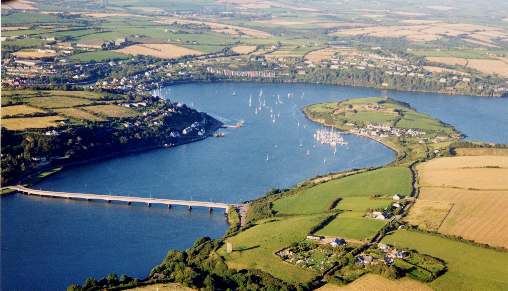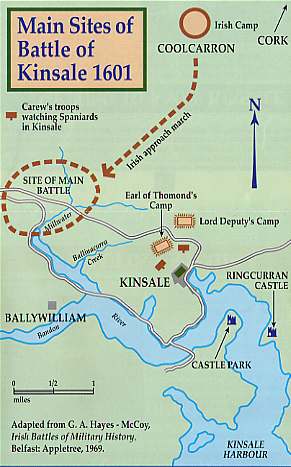1601 - The Battle of Kinsale.
|
|
Kinsale's Battle of 1601 - Main Sequence of Events.
|
|
| 22-Sept-1601 | Led by Don Juan deAguila,over 3000 Spanish troops arrive in Kinsale. Welcomed by the local people, the Spaniards are housed in Ringcurran castle, (Site of Charles Fort) and Castlepark (Site of James Fort). The Irish, under O'Neill had requested that the Spanish land North of the Shannon - that they might be nearer their power base- but for unknown reasons this was not to be. |
| Late October | England's Lord Deputy in Ireland, Lord Mountjoy, lands with 3000 soldiers at Oysterhaven, marches on and surrounds the town of Kinsale. |
| Early December | Mountjoy increased his force to 7000 men. Fierce fighting had now taken place and the strongholds at Ringcurran and Castlepark had been overrun. The Spaniards now hold only the ramparted town of Kinsale. |
| Mid December |
The Irish forces under O'Neill and O'Donnell had taken the remarkable march which spanned the length of Ireland. They numbered over 6000 troops. This force sets up camp west of Kinsale and immediately cuts Mountjoy's supply line to Cork. Over 200 more Spaniards, under Alonzo de Campo, now land West of Kinsale and link with the Irish force. The main Spanish force of 3000 is still besieged in Kinsale and no longer can play any part in the developments. |
| 24-December | The battle begins between 5000 Irish and 3000 English troops after the Irish have marched over 5 km of very wooded and inaccessible terrain at night in appalling weather. Over 4000 other English troops maintain the siege on Kinsale. Pikes, swords, haliberds and some firearms would have been the primary weapons. The English were aware of Irish plans - which were already coming apart due to extremely stormy weather in the preceding days - and caught the Irish forces out of position.. A short, fierce battle took place. O'Neills troops were dispersed and fled. As already mentioned, O'Donnell's troops had acted independently. Most of his troops had now fled. The English claim over 1000 Irish dead, few casualties and the battle. |
| Aftermath | Nine days later, the Spanish forces surrender and are allowed safe passage back to Spain. James's fort was quickly built to prevent a further situation occurring in Kinsale. O'Neill and O'Donnell return to Northern Ireland. In 1603 they were forced to submit to Mountjoy. In 1607 they left for Europe, never to return. This exile marked the end of the old Gaelic order and the flight of the Earls, those taking part being now known as Ireland's "wild geese" who were instrumental in forming many of Europe's Irish colleges and regiments. Their departure allows the "plantations" of Ulster with settlers loyal to the King - the effects of which are still felt today. |

Castlepark and James' Fort (right middle distance). Compass Hill (on the left) was used by MountJoy as a placement for guns to bombard the Spaniards in Castlepark during the early stages of the siege. In the later assault by foot soldiers, the English forces had first to ford the Bandon river some miles upriver. The Battle of Kinsale itself was also fought on a creek of this river approximately 3 miles upstream (left) of the bridge pictured above.
![]()



